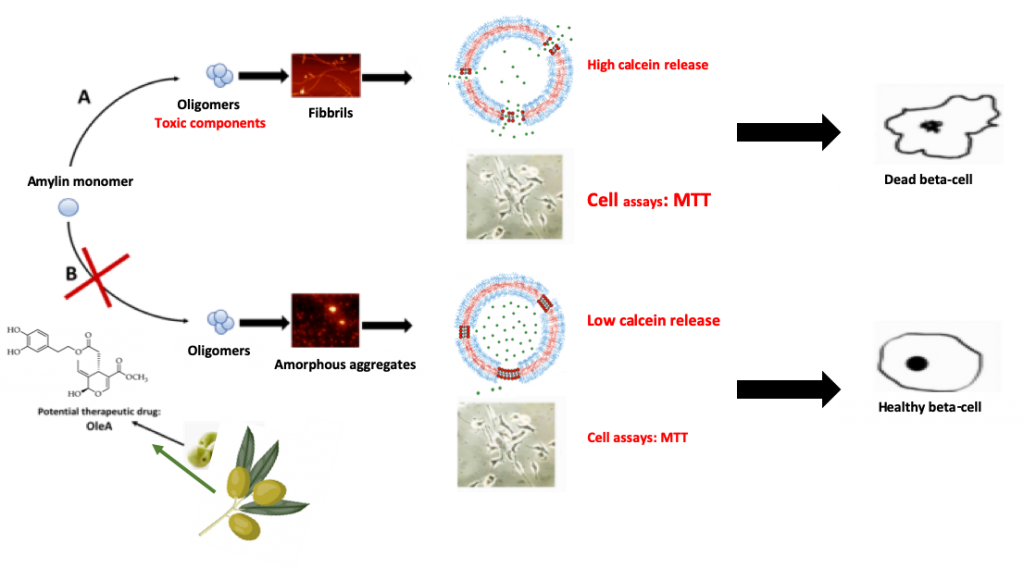By Ali Chaari
The loss of b-cell function and b-cell death is the key feature of type 2 diabetes (T2DM). Different hypothesis is presented to contribute to this disease including amyloid formation by the human islet amyloid polypeptide (hIAPP). Despite the prevalence of T2DM on the world, there are no therapeutic strategies for the treatment or prevention of amylin amyloidosis. Clinical trials and population studies indicate the healthy virtues of the Mediterranean diet especially the extra virgin olive oil enriched in phenolic compounds showed to be effective against several aging and lifestyle diseases including their action in relation of amyloid deposits related diseases.
In fact, in the last decade, increasing interest has been focused on plant polyphenols not only for their antioxidant properties but also due to their ability to inhibit amyloid fibril growth and to destabilize preformed fibrils (1,2). Many pieces of evidence support the widely recognized assumption that the Mediterranean diet is greatly beneficial for the prevention of several diseases ranging from atherosclerosis to cancer (3,4). In this respect, attention has been paid to the role of polyphenols, mainly those occurring in extra virgin olive oil. Together these molecules, with other minor components of extra virgin olive oil (EVOO), have attracted considerable interest due to their biological and pharmacological properties including erythrocyte protection, anti-cancer, anti-microbial, anti-hypertensive and antimicrobial effects (5,6). In fact, olive oil is a source of at least thirty natural phenolic compounds (7). Among these, tyrosol (TYR) (hydroxytyrosol (HT) (3,4-dihydroxyphenylethanol), oleuropein glucoside (Ole) and oleuropein aglycone (OleA) are found in highest concentration (Figure 1). The concentration of HT in olive oil is in the 1.4–5.6 mg/L range and its reported 14.42 ± 3.01 mg/kg in EVOO and the concentration of TYR is almost in the same range. Ole, the polyphenolic compound containing a hydroxytyrosol moiety linked to a glycosylated elenolic acid, covers the 2.3–9.0 mg/L concentration range in olive oil (7) and is reported at 2.04 ± 0.78 mg/kg in EVOO, while the concentration of OleA ranges from 7.5 to 158 mg/kg (8–10) .
So far, the role of oleuropein and its metabolites against hIAPP fibril formation and toxicity has not been studied. In this study, we selected and compared the potential inhibitory activities of four compounds; tyrosol, hydroxytyrosol, oleuropein and oleuropein aglycone (Figure 1). The main purpose of this work is to study the effect of these natural polyphenols, found in Mediterranean diet mainly in olive oil, against hIAPP aggregation and fibril formation and hIAPP aggregates toxicity and as a consequence, their capacity to combat T2DM. To do this end, a range of biophysical and cellular techniques have been employed in order to establish a systematic approach to improve understanding the potential “nutraceuticals” for preventing T2DM and epidemic aging syndromes related to protein misfolding and aggregation.

Figure 1: Structures of oleuropein glucoside and its derivatives: tyrosol (TYR), hydroxytyrosol (HT), oleuropein aglycone (OleA) and Elenolic acid.
Results and Conclusion
In order to emphasize the inhibitory effect of the main phenolic constituents of the olive oil, TYR, HT, Ole and OleA on hIAPP aggregation, high-throughput ThT, fluorescence and AFM tests with cell-based toxicity tests were complemented in order to validate the best phenolic compound in terms of protecting pancreatic b-cells from toxic hIAPP aggregates. Our results show that OleA one of the major metabolites of Ole did not only inhibit hIAPP fibril formation process by delaying the lag phase and the formation of nucleus oligomers but also did protect the pancreatic cells against hIAPP toxicity by decreasing its permeabilization. Altogether, the analysis of our results and the structure comparison of OleA with the three other polyphenols give an evidence that the presence of an aldehyde moieties in the tautomeric forms of the OleA increases its inhibitory capacity comparing the hydoxytyrosol which was showed to be the common structure in the HT, Ole and OleA.
Moreover, the amyloid proteins have been demonstrated to share biochemical characteristics and recent studies suggested that Alzheimer disease may be linked to brain insulin resistance in diabetes mellitus suggestion that OleA can not only reduce the risk of developing T2DM but also can reduce the risk of neurodegenerative disorders. In light of our results and analysis, we suggest that these natural polyphenolic compounds and specially OleA provided from Mediterranean diet and consumption of EVOO may provide a chemical basis for the development of hIAPP and other amyloid polypeptides aggregation inhibitors (Figure 2).

For more update about the results please read the paper published in International Journal for Biological Macromolecules through the bellow link:
https://authors.elsevier.com/a/1bIbwWFfgiv-%7E

Dr. Ali Chaari, P.h.D in Biochemistry and Biophysics. He is currently a Lecturer in Biochemistry in Weill Cornell medicine-Qatar. Dr. Chaari is experienced in biochemistry, molecular biology, and biophysics. He has co-authored several original research articles, written two books and has presented his work at several conferences. In addition, he is active as a research mentor to WCM-Q’s medical students. Two active research areas are 1) the study of amyloid proteins modulation in neurodegenerative diseases and diabetes and 2) the effect probiotics on health.
Email: alc2033@qatar-med.cornell.edu
Alternative email: ali.chaari@yahoo.fr
Contact Number: +974 33593586
LinkedIn: https://www.linkedin.com/in/ali-chaari-81637340/
ResearchGate: https://www.researchgate.net/profile/Ali_Chaari
References:
- Leri M, Natalello A, Bruzzone E, Stefani M, Bucciantini M. Oleuropein aglycone and hydroxytyrosol interfere differently with toxic Aβ1-42 aggregation. Food Chem Toxicol [Internet]. 2019 Jul 1 [cited 2020 Jan 6];129:1–12. Available from: https://www.sciencedirect.com/science/article/pii/S0278691519302145?via%3Dihub#bib83
- Stefani M, Rigacci S. Protein Folding and Aggregation into Amyloid: The Interference by Natural Phenolic Compounds. Int J Mol Sci [Internet]. 2013 Jun 13 [cited 2020 Jan 6];14(6):12411–57. Available from: http://www.mdpi.com/1422-0067/14/6/12411
- Rigacci S, Guidotti V, Bucciantini M, Parri M, Nediani C, Cerbai E, et al. Oleuropein aglycon prevents cytotoxic amyloid aggregation of human amylin. J Nutr Biochem [Internet]. 2010 Aug 1 [cited 2020 Jan 6];21(8):726–35. Available from: https://www.sciencedirect.com/science/article/pii/S0955286309001004?via%3Dihub#bib11
- Dhouafli Z, Cuanalo-Contreras K, Hayouni EA, Mays CE, Soto C, Moreno-Gonzalez I. Inhibition of protein misfolding and aggregation by natural phenolic compounds. Cell Mol Life Sci [Internet]. 2018 Oct 20 [cited 2020 Jan 6];75(19):3521–38. Available from: http://link.springer.com/10.1007/s00018-018-2872-2
- Haris Omar S. Oleuropein in Olive and its Pharmacological Effects. Sci Pharm [Internet]. 2010 [cited 2020 Jan 6];78(2):133–54. Available from: http://www.mdpi.com/2218-0532/78/2/133
- Bendini A, Cerretani L, Carrasco-Pancorbo A, Gómez-Caravaca A, Segura-Carretero A, Fernández-Gutiérrez A, et al. Phenolic Molecules in Virgin Olive Oils: a Survey of Their Sensory Properties, Health Effects, Antioxidant Activity and Analytical Methods. An Overview of the Last Decade Alessandra. Molecules [Internet]. 2007 Aug 6 [cited 2020 Jan 6];12(8):1679–719. Available from: http://www.mdpi.com/1420-3049/12/8/1679
- Amiot MJ, Fleuriet A, Macheix JJ. Importance and evolution of phenolic compounds in olive during growth and maturation. J Agric Food Chem [Internet]. 1986 Sep [cited 2020 Jan 6];34(5):823–6. Available from: https://pubs.acs.org/doi/abs/10.1021/jf00071a014
- Tovar MJ, Motilva MJ, Romero MP. Changes in the Phenolic Composition of Virgin Olive Oil from Young Trees ( Olea europaea L. cv. Arbequina) Grown under Linear Irrigation Strategies. J Agric Food Chem [Internet]. 2001 Nov [cited 2020 Jan 6];49(11):5502–8. Available from: https://pubs.acs.org/doi/10.1021/jf0102416
- Brenes M, García A, García P, Garrido A. Acid Hydrolysis of Secoiridoid Aglycons during Storage of Virgin Olive Oil. J Agric Food Chem [Internet]. 2001 Nov [cited 2020 Jan 6];49(11):5609–14. Available from: https://pubs.acs.org/doi/10.1021/jf0107860
- Brenes M, García A, García P, Garrido A. Rapid and Complete Extraction of Phenols from Olive Oil and Determination by Means of a Coulometric Electrode Array System. J Agric Food Chem [Internet]. 2000 Nov [cited 2020 Jan 6];48(11):5178–83. Available from: https://pubs.acs.org/doi/10.1021/jf000686e

